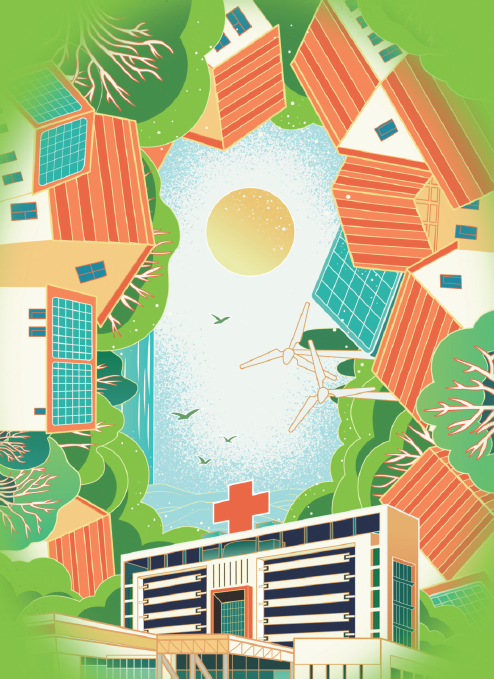High-tech health services ease burden

[Shi Yu/China Daily]
Remote diagnosis and telemedicine among tools used to bring top-notch healthcare to remote areas
For years, one of the greatest fears facing elderly residents of Mayi Island in Zhejiang province was the exhausting trip to hospital when they fell sick.
"From waiting for a ferry to get off the island, to riding the bus to the county seat, it used to take the whole day for me to see a doctor," said Lin Zhongsu, a Mayi resident.
Today, Lin is able to get diagnosed by experienced doctors in larger cities in Zhejiang without even having to leave the island's small clinic thanks to concerted efforts to bring high-quality medical care to remote and rural areas.
In Lin's case, 5G-powered augmented reality glasses enabled doctors based thousands of miles away in Zhoushan and Hangzhou to conduct the examination and find out about his symptoms.
The adoption of digital tools is part of the latest efforts by China to promote the sound development of the medical system in its rural areas.
The general offices of the Communist Party of China Central Committee and the State Council recently released a circular detailing their goals of balancing the layout of medical institutions, improving infrastructure, and developing well-rounded teams of health professionals in rural areas by 2025.
Official data shows that there were about 17,000 county-level hospitals, 35,000 township clinics and nearly 600,000 village clinics across China's vast countryside at the end of 2021.
Qin Jiangmei, a researcher from the China National Health Development Research Center, said that the average life expectancy for rural residents has increased from 74.1 years in 2010 to 76.8 in 2020. Between 2009 and 2021, the rural mortality rates for infants, children under five and the maternal mortality rate — all key indicators of a region's level of health service — have all dropped by over 50 percentage points.
"More than 85 percent of rural residents are now able to reach the nearest medical service provider within 15 minutes," she said, adding that basic medical insurance now covers over 95 percent of rural residents.
However, given the country's rapidly aging population, and the growing burdens of chronic illness and the increasing health demands of the countryside, the gap between urban and rural medical services has become more noticeable in recent years.
Qin said that a lack of medical professionals is badly hampering the advancement of healthcare services in rural areas. "The academic credentials of rural medical workers are relatively low, and there is a shortage of well-trained general practitioners," she said. "Rural doctors are in short supply, they are aging, and they are not as highly trained."
Qin said that the lackluster medical service in rural areas is being manifested in the decreasing numbers of visits to township or village clinics among total hospital visits nationwide in recent years.
Data shows that visits to rural medical facilities accounted for 44.3 percent of total visits in 2009, but fell to 29.5 percent in 2021, and the percentage of hospitalizations at rural facilities also fell from 28.7 to 13 percent during the same period.
"While rural migration to cities has played a role in these changes, they also reflect the fact that greater efforts are needed to channel medical resources to the grassroots level, especially at the township and village levels," she said.
Measures listed in the document include leveraging smart and digitalized technologies to deliver healthcare services. "Technologies such as remote consultation, the appointment-based transferral of patients, online follow-up consultations and remote examinations should be promoted, and the use of artificial intelligence-assisted diagnoses should be accelerated at rural healthcare institutions," the report stated.
In Zhejiang's mountainous Shawan township, the 50-minute ride to the county seat hospital in Jingning She autonomous county made it difficult for 77-year-old Liu Yuyu to see doctors when he was having trouble controlling his high blood pressure.
"I grew used to putting up with discomfort from my condition for as long as I could," he said. "But now, using the remote diagnosis platform set up in the nearby clinic, I am able to see doctors from top hospitals in Hangzhou without needing to leave town. It's marvelous."
Lei Yehua, a rural doctor in Shawan township, who helps facilitate remote consultation sessions, said: "We grassroots doctors have also learned a lot by being able to discuss cases with specialists from larger hospitals."
Local authorities said that since the remote medical service was launched at Jingning county hospital in late 2022, it has diagnosed 300 patients, and provided health management advice for 1,500 people in the jurisdiction. It is estimated that patients living in remote areas have saved around 700,000 yuan ($101,000) on travel expenses as a result.
In addition, the document highlighted the need to improve incomes and benefits for rural doctors in order to encourage more medical professionals to work in the countryside.
It suggested that local authorities raise subsidies and arrange accommodation for rural health workers in far-flung and impoverished areas, especially in less developed middle and western provinces and also requested that local governments increase the pensions of rural doctors currently aged 60 or above.
Mou Shanyong, deputy director of the Shandong Health Commission said last month that the province has designated 407 hospitals to serve as training centers for grassroots medical workers to make it simpler for them to improve their medical skills.
























